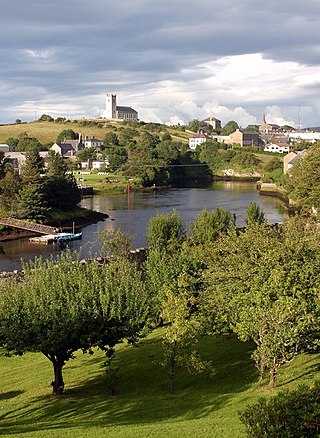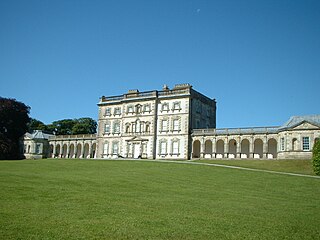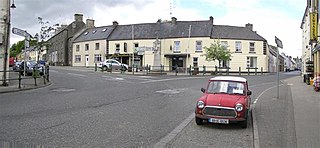Features

The estate is open to the public for recreational activities and weddings. [1] The ruins of the old castle, a bowling green and garden are tourist attractions. [2] Several cottages are available to rent on the estate.
The Crom Estate (pronounced K-ROM') is a nature reserve located in the south of County Fermanagh, Northern Ireland, along the shores of Upper Lough Erne. It is one of three estates owned and managed by the National Trust in County Fermanagh, the others being Florence Court and Castle Coole mansions. The estate comprises 1,350 acres (5.5 km2), composed primarily of riparian forest. Some trees are so ancient that physical access is restricted.

The estate is open to the public for recreational activities and weddings. [1] The ruins of the old castle, a bowling green and garden are tourist attractions. [2] Several cottages are available to rent on the estate.
Like many Ulster country estates, the first house at Crom was built by a Scottish Planter at the beginning of the 17th century. In 1611, as part of the Plantation of Ulster, Michael Balfour, the Laird of Mountwhinney, constructed a house on the lough shore opposite Inishfendra Island. Following the usual pattern for a Plantation castle, it was built of lime and stone and enclosed within a bawn. The castle was invaded twice by believers of the Jacobitism before it was burnt down in the early 1760s. The ruins of this castle still survive today. In 1840 a new neo-Tudor Crom Castle was built, designed by Scottish architect Edward Blore. It remains the property of the Earl of Erne and is not open to the public. The estate was given to the National Trust by The 6th Earl of Erne (often known as Harry Erne) in 1987. [2]
Crom Estate was the location of a great Classic yacht and steamboat regatta in August 2010 when the races of the 1890s were recreated in Trial bay using Norfork Broads One-Designs (brown boats), Lough Erne Fairies, Fife One Designs from Anglesey, and a pair of Colleens. Racing took place on Upper Lough Erne within sight of the castle, and the boats moored each evening off the boathouse in Crom Bay.[ citation needed ]

County Fermanagh is one of the thirty-two counties of Ireland, one of the nine counties of Ulster and one of six counties of Northern Ireland

Lough Neagh is a freshwater lake in Northern Ireland and is the largest lake on the island of Ireland and in the United Kingdom. It has a surface area of 151 square miles and is about 19 miles (31 km) long and 9 miles (14 km) wide. According to Northern Ireland Water, it supplies 40.7% of Northern Ireland's drinking water. Its main inflows are the Upper River Bann and Blackwater, and its main outflow is the Lower Bann. There are several small islands including Ram's Island, Coney Island and Derrywarragh Island. The lake bed is owned by the 12th Earl of Shaftesbury and the lake is managed by Lough Neagh Partnership. Its name comes from Irish Loch nEachach, meaning "Eachaidh's lake".

Earl Erne, of Crom Castle in the County of Fermanagh, is a title in the Peerage of Ireland. It was created in 1789 for John Creighton, 2nd Baron Erne, who had earlier represented Lifford in the Irish House of Commons. He had already been made Viscount Erne, of Crom Castle in the County of Fermanagh, in 1781, also in the Peerage of Ireland, and sat from 1800 to 1828 as an Irish Representative Peer in the British House of Lords. The title of Baron Erne, of Crom Castle in the County of Fermanagh, was created in the Peerage of Ireland in 1768 for his father Abraham Creighton. The Earl was succeeded by his eldest son, the second Earl. On his death the titles passed to his nephew, the third Earl. He was an Irish Representative Peer from 1845 to 1885 and also served as Lord Lieutenant of County Fermanagh during the same period. In 1876 he was created Baron Fermanagh, of Lisnaskea in the County of Fermanagh, in the Peerage of the United Kingdom. This was to allow the Earls to sit in the House of Lords by right, rather than having to stand for election as Representative Peers. An earlier title of Baroness Fermanagh in the Peerage of Ireland was created for Mary Verney on 13 June 1792, but became extinct on her death on 15 November 1810.

Lough Erne is the name of two connected lakes in County Fermanagh, Northern Ireland. It is the second-biggest lake system in Northern Ireland and Ulster, and the fourth biggest in Ireland. The lakes are widened sections of the River Erne, which flows north and then curves west into the Atlantic. The smaller southern lake is called the Upper Lough as it is higher up the river. The bigger northern lake is called the Lower Lough or Broad Lough. The town of Enniskillen lies on the short stretch of river between the lakes. The lake has more than 150 islands, along with many coves and inlets. The River Erne is 80 miles (129 km) long and drains an area of about 1,680 square miles (4,350 km2).

Derrygonnelly is a small village and townland in County Fermanagh, Northern Ireland. Near Lower Lough Erne, the village was home to 680 people at the 2011 Census and dates to the Plantation era. It is situated within Fermanagh and Omagh district.

Derrylin is a village and townland in County Fermanagh, Northern Ireland. It is on the A509 road between Enniskillen and the border with County Cavan. It had a population of 634 in the 2011 census and is situated within Fermanagh and Omagh district.

The River Erne in the northwest of the island of Ireland, is the second-longest river in Ulster, flowing through Northern Ireland and the Republic of Ireland, and forming part of their border.

Florence Court is a large 18th-century house and estate located 8 miles south-west of Enniskillen, County Fermanagh, Northern Ireland. It is set in the foothills of Cuilcagh Mountain. The nearby village is distinguished by the one-word name Florencecourt. It is owned and managed by the National Trust and is the sister property of nearby Castle Coole. The other National Trust property in County Fermanagh is the Crom Estate.

Pettigo, also spelt Pettigoe, is a small village and townland on the border of County Donegal, Republic of Ireland, and County Fermanagh, Northern Ireland. It is bisected by the Termon River which is part of the border between the Republic of Ireland and Northern Ireland.
Newtownbutler or Newtown Butler is a small village in County Fermanagh, Northern Ireland. It is in the southeast corner of the county, near Lough Erne, the border with County Monaghan, Republic of Ireland, and the town of Clones. It is surrounded by small lakes and bogland. In the 2011 Census it had a population of 989 people.

Donegal Castle is a castle situated in the centre of Donegal Town in County Donegal in Ulster, the northern province in Ireland. The castle was the stronghold of the O'Donnell clan, Lords of Tír Conaill and one of the most powerful Gaelic families in Ireland from the 5th to the 16th centuries. For most of the last two centuries, the majority of the buildings lay in ruins but the castle was almost fully restored in the early 1990s. It is now open to the public.


Killadeas is a small village in County Fermanagh, Northern Ireland. It is about 7 miles north of Enniskillen near the shores of Lower Lough Erne, and is within Fermanagh and Omagh district. In the 2001 Census it had a population of 90 people.

White Island is an island in Lower Lough Erne, County Fermanagh, Northern Ireland. It is situated in Castle Archdale Bay off the east shore of Lower Lough Erne. The ruins of an ancient church are found near the shore, built on the site of an earlier monastic settlement. It still has an intact arched Romanesque doorway. The Church and carved figures are State Care Historic Monuments sited in the townland of White Island, in Fermanagh and Omagh District Council area, at grid ref: H1753 6000. The rath, earthwork, and area surrounding the state care monument are Scheduled Historic Monuments, at grid ref: H1753 6000. The island is accessed by ferry from the marina in Castle Archdale Country Park, near Irvinestown. Location: OpenStreetMap Reference
Castle Archdale in County Fermanagh, Northern Ireland is a former estate on the shores of Lough Erne Lower, the key feature of which today is Castle Archdale Country Park. There is also a caravan park. The former estate is situated near Lisnarick and Irvinestown, in the broader hinterland of Enniskillen, and the park is owned and run by the Northern Ireland Environment Agency.

Castle Saunderson is a castle near Belturbet in County Cavan, Ireland. It was the former family seat of the Saunderson family, and is now in ruins. The Finn River flows along the north-eastern edge of the Castle Saunderson Demesne, where the river enters a narrow channel of Upper Lough Erne. The castle is about a half a mile west from Wattlebridge, a small hamlet in the south-south-east of County Fermanagh.
Derryvore is the name of three townlands in Northern Ireland.
Crom Castle is a country house on the shores of Upper Lough Erne in County Fermanagh, Northern Ireland, the seat of the Earls Erne. Standing within the 1,900-acre (7.7 km2) Crom Estate, and within a formal garden, the castle is built in stone. A central battlemented tower includes the main entrance, and there are also smaller towers to one side. It stands apart from the ruins of Old Crom Castle, of which two towers, some walls, and a ha-ha survive, and near them two ancient yew trees, believed to be at least 800 years old.

The Cuilcagh Lakelands Geopark formerly known as the Marble Arch Caves Global Geopark straddles the border between Northern Ireland and the Republic of Ireland. It is centred on the Marble Arch Caves and in 2001 it became one of the first geoparks to be designated in Europe.

Ninnidh was a 6th-century Irish Christian saint. St. Ninnidh is regarded as one of the Twelve Apostles of Ireland. He is associated with the shores of Lough Erne and particularly the island of Inishmacsaint and the parish of Knockninny, County Fermanagh, Northern Ireland. His feast day is 18 January.